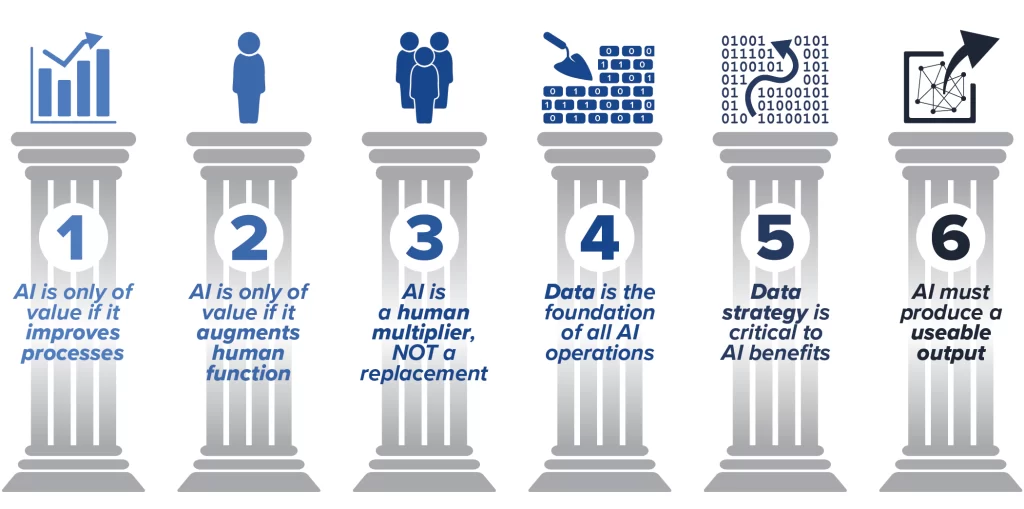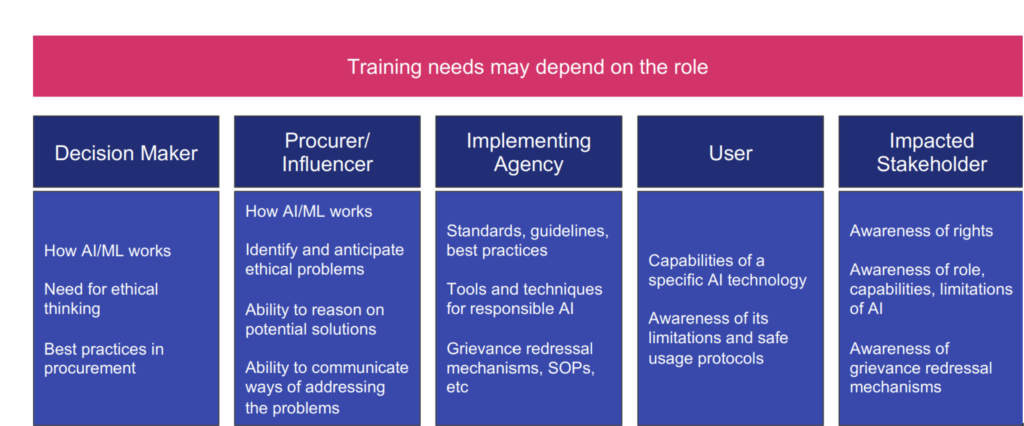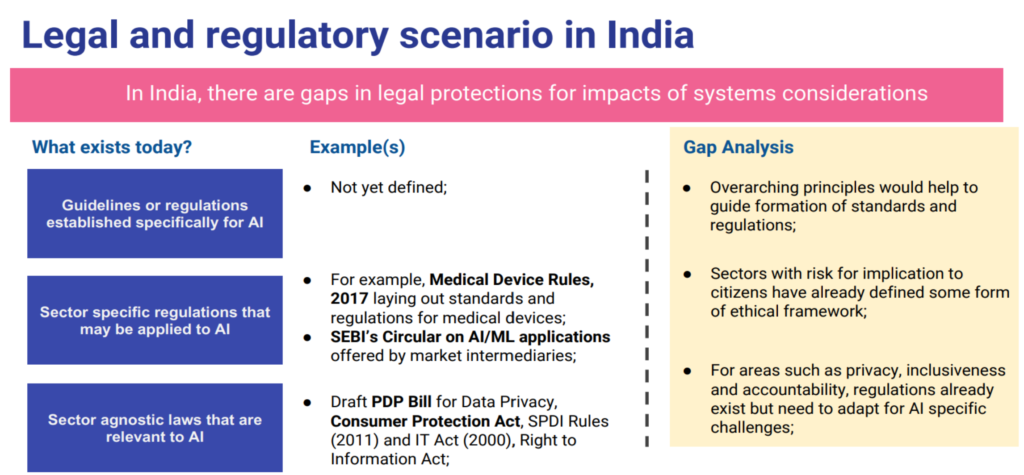“Technology is by itself is value neutral, it’s specific use where to put creates a value”
The 21st century has witnessed a remarkable surge in technological advancements. The rapid evolution of technology in recent decades has fundamentally altered our perspectives, lifestyles, and work methods. The global pandemic, in particular, has compelled humanity to explore innovative solutions through the power of Artificial Intelligence (AI).
Artificial intelligence, often abbreviated as AI, encompasses the capacity of machines to execute cognitive functions such as critical thinking, perception, learning, problem-solving, and autonomous decision-making. This transformative technology has opened up new horizons for tackling a myriad of challenges in today’s dynamic world.
Exploring Artificial Intelligence
The concept of Artificial Intelligence (AI) can be traced back to ancient Greek mythology, reflecting humanity’s early fascination with the idea of creating intelligent, non-human entities. The modern journey of AI began with the development of stored computing programs.
The term “Artificial Intelligence” was officially coined in 1956, marking a significant milestone in the realm of technology. This pivotal moment occurred during the Dartmouth conference in Hanover, New Hampshire, USA, where experts from around the world gathered to delve into the potential of AI. This event laid the foundation for exploring the capabilities of machines in addressing complex social issues by harnessing knowledge, data, and computational power.
Notably, India has made commendable strides in the field of AI, ranking third in terms of research and development and 9th in the global count of AI specialists. This underscores India’s growing significance in the realm of AI, showcasing its potential to shape the future of this transformative technology.

Unlocking the Potential of Artificial Intelligence:
Artificial Intelligence (AI) stands as a remarkable innovation, offering efficiency in tasks that humans traditionally carried out. However, AI approaches these tasks from a different angle, often yielding superior outcomes.
AI’s applications are diverse, and its potential is truly transformative. For instance, in the field of healthcare, where the demand for medical attention often outpaces the supply of doctors, AI steps in as a valuable ally. It can perform initial diagnostic assessments, a particularly significant service in remote areas where medical professionals are scarce. Moreover, the integration of bio-sensors allows AI to predict impending heart attacks, affording crucial time to reach the hospital promptly.
Education, another sector significantly impacted by Artificial Intelligence, benefits from its ability to complement the role of a teacher. In agriculture, AI serves as a guardian, predicting the arrival of pests, optimizing irrigation processes, and even replacing traditional methods of bird-scaring.
In the realm of transportation, Artificial Intelligence emerges as a problem solver, offering solutions to traffic congestion, enabling timely road repairs, and efficiently managing traffic flow. The potential of AI to augment human efforts and streamline various domains is a testament to its immense promise in shaping the future.
GLOBAL PRACTICES

ROLE OF REGULATING BOARD
1. Manage and update principles for responsible AI in India
2. Enable access to responsible AI tools and techniques
3.Research technical, legal, policy, societal issues of AI
4.Education and awareness on responsible AI
5.Represent India (other emerging economies) in international AI dialogue on responsible AI
6.provide clarity on responsible behaviour through design structures, standards, guidelines, etc
7.Coordinate with various sectoral AI regulators, identify gaps and harmonize polices across sectors
ROLE BASED TRAINING

NEED FOR PRINCIPLES
The Government
- Develop polices that may impact AI procure AI systems
Private sector
- Develop AI products and solutions use AI product and solutions
Citizens
- Influence by AI systems, either directly or indirectly
Research Community
- Research across social sector, regulation, technologies and innovation in AI
Regulators
- Oversee sector specific/sector agnostic rules and regulations
Standard Setting Bodies
- Set standard for research or technology that may use AI. Ex. BIS , ICMR
Tailored AI Strategies
1. RISK ACROSS CASES
| Use Case | Description |
|---|---|
| Autonomous Vehicle Safety | Ensuring safety and reliability of self-driving vehicles. |
| Credit Lending Discrimination | Detecting and preventing discriminatory lending practices. |
| Fraud Detection in Health Care | Identifying and mitigating fraudulent activities in healthcare. |
| Inclusion | Promoting inclusivity and diversity through AI applications. |
2. Deployment Risk
| Technology | Description |
|---|---|
| Face Recognition | Assessing the risks in deploying face recognition technology. |
| Unlocking Phone | Analyzing the risks associated with using facial recognition to unlock phones. |
| Surveillance | Evaluating the deployment risks of face recognition in surveillance systems. |
3. Enforcement
| Sector | Regulators |
|---|---|
| Health | NeHA, NMC, Drug Control General |
| Finance | SEBI, PFRDA, IRDAI |
Key Principles of Ethical AI:
- Safety and Reliability: Ensuring AI systems are dependable and secure.
- Equality: Treating all individuals fairly and without bias.
- Inclusivity and Non-Discrimination: Making AI accessible and free from prejudice.
- Privacy & Security: Safeguarding personal information and data.
- Transparency: Being open and clear about AI’s functioning and decision-making processes.
- Accountability: Holding responsible parties answerable for AI system behavior.
- Protection & Reinforcement of Positive Human Values: Supporting and promoting human well-being through AI applications.
Challenges in Artificial Intelligence Implementation
| No. | Challenge | Description |
|---|---|---|
| 1 | Biased Data | AI may inherit biases from human-provided data. |
| 2 | Error Correction | Rectifying AI mistakes can be complex. |
| 3 | Accountability | Determining responsibility for AI errors is challenging. |
| 4 | Legal Implications of Errors | Legal frameworks for AI mistakes need clarity. |
| 5 | Communication with AI | Interaction with AI systems may pose difficulties. |
| 6 | Data Protection | Ensuring data privacy is vital for AI applications. |
| 7 | Promoting National Priorities | Encouraging AI alignment with national objectives is crucial. |
| 8 | Cybersecurity | Protecting AI systems from cyber threats is essential. |
| 9 | Ethical Usage | Ensuring responsible and ethical AI applications. |
| 10 | Algorithm Neutrality | Striving for unbiased algorithms is imperative. |
| 11 | Unintended Consequences | AI systems may produce unforeseen outcomes. |
| 12 | Technology Misuse | Preventing harmful misuse of AI technology. |
| 13 | Deepfakes | Addressing the challenges of deepfake content. |
| 14 | Social Media Impact | AI’s influence on social media raises concerns. |
| 15 | Privacy Issues | Safeguarding individual privacy in AI utilization. |
| 16 | Security Concerns | Ensuring AI systems are secure from vulnerabilities. |
| 17 | Trustworthiness of Knowledge | Relying on AI for knowledge may be questionable. |
| 18 | Inequality Amplification | AI could worsen existing societal inequalities. |
Artificial Intelligence Solutions for Agriculture

| Solution | Description |
|---|---|
| Soil Health Monitoring & Restoration | Innovative tools like Plantix, developed by Berlin start-up PEAT, assist in soil health monitoring and restoration. |
| Crop Health Monitoring and Advisory | AI-driven solutions, such as the AI Sowing App developed by Microsoft and ICRISAT, monitor crop health and provide real-time action advisories to farmers, enhancing farm mechanization. |
| Herbicide Reduction | Technologies like Blue River enable farmers to reduce herbicide application, benefitting both the environment and farm economics. |
| Fair Price for Producers | AI can help increase the share of price realization for producers, ensuring fair compensation for their agricultural products. |
| Precision Farming | Collaborative efforts such as NITI AAYOG and IBM’s crop yield prediction model offer real-time advisory to farmers, promoting precision farming practices. |
Artificial Intelligence Solutions for Education

| Solution | Description |
|---|---|
| Adaptive Learning Tools | AI-driven adaptive learning tools offer personalized learning experiences to students, catering to their individual needs and progress. |
| Intelligent and Interactive Tutoring Systems | Smart tutoring systems use AI to provide interactive and intelligent guidance to students, aiding them in their learning journeys. |
| Smart Content | AI helps develop smart content that enhances the learning process, making educational materials more engaging and effective. |
| Predictive Tools for Dropout Prevention | Predictive AI tools analyze data to identify students at risk of dropping out and enable timely intervention, reducing dropout rates. |
| Automated Teacher Rationalization | AI can automate the process of teacher allocation, ensuring efficient resource utilization within the education system. |
| Customized Professional Development Courses | AI-driven customization of professional development courses empowers educators to enhance their teaching skills and knowledge. |
| Writing Skills Enhancement (e.g., Pearson’s WritetoLearn) | AI-powered software, like Pearson’s WritetoLearn, provides students with hints and tips to improve their writing skills. |
Artificial Intelligence Solutions for Smart Cities

| Solution | Description |
|---|---|
| Smart Parks and Public Facilities | AI contributes to making parks and public facilities more efficient and enjoyable, enhancing the urban experience for residents. |
| Smart Homes | AI empowers smart homes with features like automated energy management, security, and improved overall living conditions. |
| AI-Driven Service Delivery | Artificial intelligence optimizes service delivery in smart cities, ensuring better resource allocation and enhanced efficiency. |
| Crowd Management (e.g., Kumbh Mela Experiment) | AI aids in crowd management during large-scale events, promoting safety and facilitating smoother event organization. |
| Intelligent Safety Systems | AI-based safety systems enhance urban security by providing real-time monitoring, threat detection, and rapid response capabilities. |
| Cybersecurity | Smart cities rely on AI to protect against cyber threats and vulnerabilities, ensuring data and infrastructure security. |
Artificial Intelligence Solutions for Smart Mobility

| Solution | Description |
|---|---|
| Autonomous Trucking (Improving Road Capacity) | AI-driven autonomous trucking systems enhance road capacity, enabling efficient and safe freight transportation. |
| Intelligent Transport System | Incorporating technologies like CCTV cameras, automatic number plate recognition cameras, speed detection cameras, toll monitoring, and advanced road geometric design for safer and smarter transportation systems. |
| Travel Route and Flow Optimization | AI-based prediction models offer optimized travel routes and flow management, improving journey time efficiency and road safety for both public and private vehicles. |
| Community-Based Parking (Complex Vehicle Grid Interactions) | Implementing AI for community-based parking solutions that manage complex interactions in vehicle parking grids for enhanced urban mobility. |
Artificial Intelligence Solutions for the Health Sector

| Solution | Description |
|---|---|
| Augmenting Scarce Personnel and Lab Facilities | AI plays a crucial role in enhancing limited medical personnel and lab capabilities, optimizing healthcare delivery. |
| Improving Accessibility | Addressing accessibility issues in healthcare by providing remote medical assistance, overcoming geographical barriers. |
| Early Detection, Diagnosis, and Treatment | Artificial Intelligence aids in early detection, diagnosis, and treatment planning, significantly improving healthcare outcomes. |
| Decision-Making Support | AI offers decision-making support for healthcare professionals, ensuring data-driven and informed choices. |
| AI for Cancer | Utilizing AI for cancer-related applications like digital pathology, cancer imaging bio-banking, and radiomics analysis. |
| AI, Robotics, and IoT Integration | The integration of AI, robotics, and the Internet of Medical Things (IoMT) enhances healthcare solutions for better medical care. |
| Electronic Health Record Standards | Developing standardized electronic health records to streamline health information management across India. |
| Integrated Health Information Program | Implementing an integrated program for managing health information effectively. |
| National e-Health Authority | Establishing a national authority for e-health initiatives and digital healthcare services. |
Worldwide Regulations on Artificial Intelligence
| Singapore | European Union | United States of America |
|---|---|---|
| Regulations or Guidelines | ||
| 1.The IMDA (Infocomm Media Development Authority) released the Model AI Governance Framework as a guide to implementing fair, transparent, and human-centric AI. | 1.The High-Level Expert Group on AI released ethics guidelines for trustworthy AI, emphasizing ethical considerations. | 1.The “10 Principles for the Stewardship of AI Applications” prioritizes federal agency regulation drafting and implementation in the U.S. |
| Sector-Specific Regulations | ||
| 1.”Fairness, Ethics, Accountability & Transparency (FEAT) Principles for AI in Financial Services” encourages the adoption of fair, explainable, ethical, and accountable AI in the financial sector. | 1. Certain AI use cases under specific sectors are labeled as “HIGH RISK” and require stringent specifications. | 1. Regulations such as the Fair Credit Reporting Act (FCRA) and Equal Credit Opportunity Act (ECOA) mandate providing outcome-based explanations for adverse actions and ensuring non-discrimination. 2. The HIPAA Privacy Rules of 2000 and the Gramm-Leach-Bliley Act of 1999 govern data management in healthcare and finance. |
| Sector-Agnostic Laws | ||
| 1. The Personal Protection Data Act of 2012, established by the PDP committee, defines data protection laws. | 1. The General Data Protection Rules, proposed in 2016. | 1. The Algorithmic Accountability Act of 2019 aims to reduce biased decisions and outcomes. 2. The California Consumer Privacy Act of 2018 mandates data privacy and protection. |
REGULATION OF Artificial Intelligence IN INDIA

The Path Forward in the Age of Artificial Intelligence
- Skilled Workforce Preparation: Preparing a workforce for the AI era through initiatives like future skills programs.
- Educational Integration: The Central Board of Secondary Education (CBSE) has introduced AI as a subject in classes X and XII. Additionally, the new Education Policy mandates coding education from the 6th grade onward, ensuring youth are trained and prepared for the job market.
- Responsible AI Training: Implementing responsible AI training to educate young individuals on how to train machines. This program has been successful, with 50,000 students from government schools registering for the course, and 11,000 completing it.
- Collaborative Efforts: The collaboration between the Ministry of Education, Ministry of Electronics and Information Technology, and academia aims to create a robust AI workforce.
- Job Opportunities: It is estimated that by 2022, 13.4 crore AI-related jobs will be generated. Reskilling is crucial in harnessing this potential.
- Digital Readiness: Initiatives to prepare children for the digital age, including engagement with physical robots for practical learning experiences.
- Human Relevance: While Artificial Intelligence is transforming various aspects of society, humans will remain indispensable for empathy, emotional understanding, high-quality communication, and interactive relationships, all areas where robots lack proficiency.
- Pervasiveness of AI: Artificial Intelligence is expected to impact nearly every facet of daily life.
- Data Integration: Leveraging the abundance of data available across different domains to enhance AI systems, benefiting governments, the public, companies, and startups.
- Interdisciplinary Approach: The development of cyber-physical systems, with AI as a core component.
- Investment in R&D: Encouraging greater investments in research and development to advance AI technologies and applications.
- Opportunity for India: Recognizing the vast potential in the AI landscape and working towards seizing these opportunities.
In Conclusion
- Reskilling for AI Enhancement: Reskilling efforts have the potential to boost the Artificial Intelligence ecosystem. A prime example is the banking sector, where the introduction of automation and computing technology led to the creation of more jobs, ultimately improving the overall banking system. The younger generation is inherently more digitally savvy, having grown up in a digital world. We need to guide and prepare them to harness future job opportunities in this ever-evolving sector.
- Responsible AI Integration: Efforts are underway to infuse responsibility into Artificial Intelligence, as discussed at the Raise Summit 2020. These discussions aim to incorporate spiritual and philosophical dimensions into Artificial Intelligence, showcasing India’s commitment to secularism. The purpose of AI remains deeply intertwined with its service to humanity.
- Limitless Possibilities of AI: The potential applications of Artificial Intelligence are boundless, as it can be practically employed in every field. The recent pandemic underscored the burdens faced by overworked doctors, particularly in rural India. AI can significantly alleviate these pressures, with its predictive capabilities to identify and address healthcare issues proactively.
- Legal Framework: To tackle accountability and the challenges associated with errors, it is imperative to establish robust legal frameworks.
The world of AI is brimming with opportunities, and by addressing these crucial aspects, we can ensure that AI serves humanity’s best interests.

